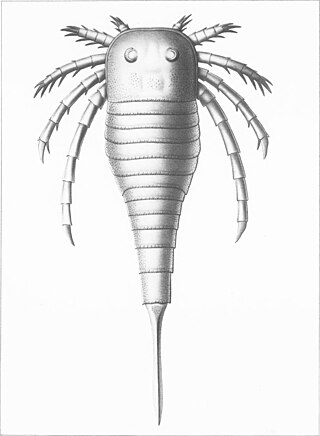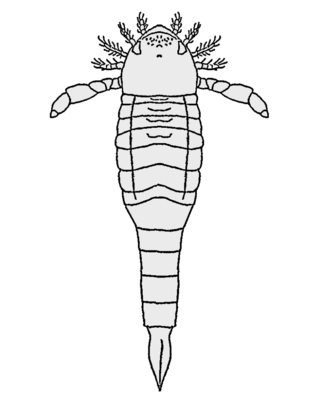
Eurypterids, often informally called sea scorpions, are a group of extinct arthropods that form the order Eurypterida. The earliest known eurypterids date to the Darriwilian stage of the Ordovician period 467.3 million years ago. The group is likely to have appeared first either during the Early Ordovician or Late Cambrian period. With approximately 250 species, the Eurypterida is the most diverse Paleozoic chelicerate order. Following their appearance during the Ordovician, eurypterids became major components of marine faunas during the Silurian, from which the majority of eurypterid species have been described. The Silurian genus Eurypterus accounts for more than 90% of all known eurypterid specimens. Though the group continued to diversify during the subsequent Devonian period, the eurypterids were heavily affected by the Late Devonian extinction event. They declined in numbers and diversity until becoming extinct during the Permian–Triassic extinction event 251.9 million years ago.

Stylonurina is one of two suborders of eurypterids, a group of extinct arthropods commonly known as "sea scorpions". Members of the suborder are collectively and informally known as "stylonurine eurypterids" or "stylonurines". They are known from deposits primarily in Europe and North America, but also in Siberia.

Slimonia is a genus of eurypterid, an extinct group of aquatic arthropods. Fossils of Slimonia have been discovered in deposits of Silurian age in South America and Europe. Classified as part of the family Slimonidae alongside the related Salteropterus, the genus contains three valid species, S. acuminata from Lesmahagow, Scotland, S. boliviana from Cochabamba, Bolivia and S. dubia from the Pentland Hills of Scotland and one dubious species, S. stylops, from Herefordshire, England. The generic name is derived from and honors Robert Slimon, a fossil collector and surgeon from Lesmahagow.

Chasmataspidids, sometime referred to as chasmataspids, are a group of extinct chelicerate arthropods that form the order Chasmataspidida. Chasmataspidids are probably related to horseshoe crabs (Xiphosura) and/or sea scorpions (Eurypterida), with more recent studies suggest that they form a clade (Dekatriata) with Eurypterida and Arachnida. Chasmataspidids are known sporadically in the fossil record through to the mid-Devonian, with possible evidence suggesting that they were also present during the late Cambrian. Chasmataspidids are most easily recognised by having an opisthosoma divided into a wide forepart (preabdomen) and a narrow hindpart (postabdomen) each comprising 4 and 9 segments respectively. There is some debate about whether they form a natural group.

Alkenopterus is a genus of prehistoric eurypterid classified as part of the family Onychopterellidae. The genus contains two species, A. brevitelson and A. burglahrensis, both from the Devonian of Germany.

Brachyopterus is a genus of prehistoric eurypterid of the family Rhenopteridae. It is one of the earliest known eurypterids, having been recovered from Middle Ordovician deposits in Montgomeryshire, Wales. Though other species have been assigned to it in the past, Brachyopterus is today recognized as containing one valid species, B. stubblefieldi.

Onychopterella is a genus of predatory eurypterid, an extinct group of aquatic arthropods. Fossils of Onychopterella have been discovered in deposits from the Late Ordovician to the Late Silurian. The genus contains three species: O. kokomoensis, the type species, from the Early Pridoli epoch of Indiana; O. pumilus, from the Early Llandovery epoch of Illinois, both from the United States; and O. augusti, from the Late Hirnantian to Early Rhuddanian stages of South Africa.
Stylonuroides is a genus of prehistoric eurypterid. The genus is classified as a stylonurine but more precise classification has proven difficult, with the genus remaining classified as incertae sedis within the suborder. The genus contains two species, S. dolichopteroides from the Silurian of Ringerike, Norway and S. orientalis from the Devonian of Lake Shunet, Southern Siberia.

Hardieopterus is a genus of prehistoric eurypterid classified within the family Hardieopteridae. The genus contains four species, all Silurian in age; H. lanarkensis and H. macrophthalmus from Scotland, H. megalops from England and H. myops from the United States.

Laurieipterus is a genus of a eurypterid classified as part of the family Stylonuridae. It contains one species, L. elegans from the Early Silurian of Scotland.

Carcinosomatidae is a family of eurypterids, an extinct group of aquatic arthropods. They were members of the superfamily Carcinosomatoidea, also named after Carcinosoma. Fossils of carcinosomatids have been found in North America, Europe and Asia, the family possibly having achieved a worldwide distribution, and range in age from the Late Ordovician to the Early Devonian. They were among the most marine eurypterids, known almost entirely from marine environments.

The Rhenopteridae are a family of eurypterids, an extinct group of chelicerate arthropods commonly known as "sea scorpions". The family is the only family currently contained in the superfamily Rhenopteroidea, one of four superfamilies classified as part of the suborder Stylonurina.

Pterygotioidea is a superfamily of eurypterids, an extinct group of aquatic arthropods. Pterygotioids were the most derived members of the infraorder Diploperculata and the sister group of the adelophthalmoid eurypterids. The group includes the basal and small hughmilleriids, the larger and specialized slimonids and the famous pterygotids which were equipped with robust and powerful cheliceral claws.

Kokomopteroidea is an extinct superfamily of eurypterids, an extinct group of chelicerate arthropods commonly known as "sea scorpions". It is one of four superfamilies classified as part of the suborder Stylonurina. Kokomopteroids have been recovered from deposits of Early Silurian to Late Devonian age in the United States and the United Kingdom.

Hibbertopteridae is a family of eurypterids, an extinct group of aquatic arthropods. They were members of the superfamily Mycteropoidea. Hibbertopterids were large, broad and heavy animals unlike virtually every other group of eurypterids, which are commonly streamlined and lightweight. Their bizarre morphology is so unusual that they in the past have been thought to represent an entirely distinct order of chelicerates. Fossils of the family first appear in deposits of Middle Devonian age and the last known fossils representing hibbertopterids are known from deposits of Late Permian age. The hibbertopterids represent the last known living eurypterids, going extinct during the Permian–Triassic extinction event or shortly before.

Waeringopteridae is a family of eurypterids, an extinct group of aquatic arthropods. The Waeringopteridae is the only family classified as part of the superfamily Waeringopteroidea, which in turn is classified within the infraorder Diploperculata in the suborder Eurypterina. The earliest known member of the group, Orcanopterus, has been recovered from deposits of Katian age and the latest known surviving member, Grossopterus, has been recovered from deposits of Siegenian age. The name Waeringopteridae is derived from the type genus Waeringopterus, which is named in honor of eurypterid researcher Erik N. Kjellesvig-Waering.

Adelophthalmidae is a family of eurypterids, an extinct group of aquatic arthropods. Adelophthalmidae is the only family classified as part of the superfamily Adelophthalmoidea, which in turn is classified within the infraorder Diploperculata in the suborder Eurypterina.

Eurypterina is one of two suborders of eurypterids, an extinct group of chelicerate arthropods commonly known as "sea scorpions". Eurypterine eurypterids are sometimes informally known as "swimming eurypterids". They are known from fossil deposits worldwide, though primarily in North America and Europe.

Vernonopterus is a genus of eurypterid, a group of extinct aquatic arthropods. Fossils of Vernonopterus have been discovered in deposits of the Carboniferous period in Scotland. The name of the genus derives from the location where the only known fossil has been discovered, Mount Vernon near Airdrie in Lanarkshire, Scotland. A single species of Vernonopterus is recognized, V. minutisculptus, based on fragmentary fossilized tergites, segments on the upper side of the abdomen. The species name minutisculptus refers to the ornamentation of scales that covers the entirety of the preserved parts of the eurypterid.

This timeline of eurypterid research is a chronologically ordered list of important fossil discoveries, controversies of interpretation, and taxonomic revisions of eurypterids, a group of extinct aquatic arthropods closely related to modern arachnids and horseshoe crabs that lived during the Paleozoic Era.




















